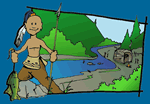


Geography and Landforms:
Hawaii, the only state not part of the mainland of North America, and the only U.S. state located in the tropics, is located approximately 2100 miles southwest of San Francisco.
|
 History:
Captain James Cook of the British navy was the first European to discover the Hawaiian Islands. He landed there on January 18, 1778 and was received warmly by the Hawaiians. Cook named these Islands the Sandwich Islands in honor of the Earl of Sandwich, the first lord of the British admiralty.
|
 Economy:
The Hawaiian Islands are one of the most desirable vacation destinations in the world. Each year millions of tourists come to enjoy the natural beauty of the islands. As a result, Hawaii's economy has become greatly dependent on service industries, retail trade, and transportation.
|
 First Inhabitants:
The earliest inhabitants of what is now Hawaii were two distinct groups of Polynesian voyagers. The first wave of settlers came between 1,000 and 1,500 years ago. The second arrived about 400 years later.
|
Books Related To HawaiiA is for Aloha: A Hawai'i Alphabet - U'ilani Goldsberry The Bottle Imp - Robert Louis Stevenson A Boy at War: A Novel of Pearl Harbor - Harry Mazer Breathless - Pam Withers Dumpling Soup - Jama Kim Rattigan Eyes of the Emperor - Graham Salisbury Healing Water: A Hawaiian Story - Joyce Moyer Hostetter House of the Red Fish - Graham Salisbury Kula and the Old Ukulele - Lance Wheeler Lord of the Deep - Graham Salisbury Luka's Quilt - Georgia Guback Lydia and the Island Kingdom: A Story Based on the Real Life of Princess Liliuokalani of Hawaii - Joan Holub The Million Dollar Putt - Dan Gutman Strange Relations - Sonia Levitan To Hawaii, with Love - Michael Spradlin |
Famous Citizens:
|
| Capital: | Honolulu |
| Entered Union: | August 21, 1959 |
| Population: | 1,419,561 |
| Area | 10,931 |
| Bird | Nene |
| Flower | Pua Aloalo |
| Nickname: | Aloha State |
| Governor | David Ige |
Places to Visit in Hawaii: (Click the links to learn more.)
|



